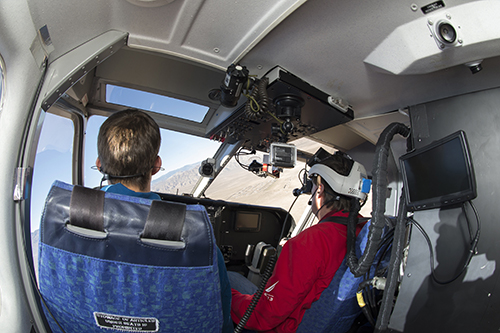Massive developmental strives in AR (augmented reality) technology have been taking place in the past couple years from major industry players such as Google and Microsoft. The tech has now entered into the aviation industry where it is used as a cutting edge training tool. One of the early plans for AR training is the Fused Reality System developed by Systems Technology and tested by NASA. It will be implemented into a real world King Air C-12 next March to practice complicated exercises in a safe manner.
Systems Technology of Hawthorne, California began development of its Fused Reality program in 2003. The inventor of the program, Ed Bachelder, and his team was able to combine real-world elements with interactive computer graphics inside the viewer of a headset (similar to Google Glass and digital pilot goggles). The end result is a view of the area around the aircraft that mixes the actual world with computer generated elements and allows trainees to practice complicated tasks and exercises. This includes runway landing at altitude, formation flying, or tracking an aerial refueling drogue. All these can be practiced without interfering with the regular operations of the aircraft.
“I’m seeing the real world through my camera, so I’m seeing mountains and clouds and the aircraft control panel, but I’m flying formation with a virtual tanker,” says pilot Scott Howe, describing a simulated formation flight with a KC-135 tanker. “I was just trying to keep station with that tanker and practice aerial refueling with the [Fused Reality] system.”
The benefits of the tech are numerous. It saves much of the cost and risk of running actual procedures while still being realistic and truth to life. It is superior to simulators which reproduce many of the elements of flight well but aren’t as adequate at training for something as complex as aerial-refueling. Tests can ran using new configurations, aircraft control algorithms, and displays under actual conditions without the need for the experimental aircraft.

Initial tests of the Fused Reality system were carried out by NASA’s Armstrong Flight Research Center at Edwards, California and the National Test Pilot School (NTPS) in Mojave. Three tests were made in 2012 using a modified Learjet in-flight simulator and then a second testing phase in September of 2014 with nine flights on board a Gippsland GA-8 Airvan research aircraft from the NTPS.
“A couple of them (test pilots) forgot that they were in a simulated environment, talking that they were really getting their blood pumping,” said Craig Milliard, a flight test engineer with the National Test Pilot School, “they felt like they were at risk when they came close to aerial refuelers or formation aircraft.”
Further testing of the system will occur during March 2015. The student pilots of the Air Force Test Pilot School’s Test Management Program will be designing a flight system using the King Air C-12 to compare the system with conventional handling qualities tasks.
NASA has also released a video talking about Fused Reality:

